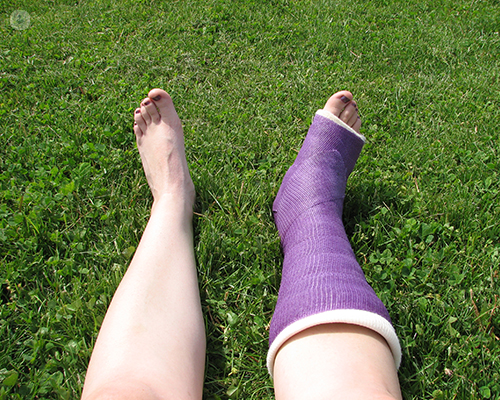Achilles tendon rupture: the important questions to consider
Written by:Mr Matthew Solan, an orthopaedic surgeon, lists the most pressing questions you should consider on rupturing the Achilles tendon.
How torn is it?
When the Achilles tendon ruptures it nearly always tears completely. Rarely, part of it may remain intact. If in doubt you should assume it is completely torn and seek medical help.

Do I need a scan?
Not for diagnosis, a physical examination will suffice, but an ultrasound scan helps in deciding the right treatment.
Why is that?
Tendons heal well without surgery as long as the torn ends are close together. If they aren’t, then a poor recovery is more likely. A scan shows if there is a gap between the torn ends or not. No gap generally means no surgery is needed. If there is a gap, then surgery to join the ends should be considered.
Why are not all tendon ruptures repaired?
Natural healing is very reliable if the rupture is fresh, you attend hospital promptly and are fitted with a cast or boot; if the ends of the tendon are close together; if the best protocol and physiotherapy is followed. If any one of these conditions is not met then there is potential for healing to be less reliable, for the tendon to re-rupture and for leg strength to be reduced.
Surgery should, of course, be avoided unless the small risks of operation are outweighed by the potential benefits.
What are the risks of surgery?
The skin over the Achilles tendon is thin, and if an infection arises in the wound or stitches it can be very serious. However, carefully placed scars and modern methods minimise this risk. Some tears are suitable for minimally-invasive (key-hole) surgery which has even lower infection risks.
Other risks include:
- Numbness due to nerve damage
- Thrombosis (this can be overcome with blood-thinners)
As an ankle specialist, how would you like your tendon rupture treated?
I’d like to have the limb in a cast or boot immediately and then have an ultrasound scan to check that there is no gap between the tendon ends. I’d have blood thinners and then follow the 10-week schedule for adjusting my splint. After this I’d work hard on my physio exercises with the help of a therapist. If the scan showed a gap between the tendon ends then I’d elect to have the tendon repaired with surgery.
If you are experiencing Achilles tendon pain, or have injured your Achilles tendon, seek medical help and make an appointment with an expert.


